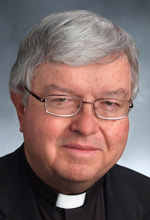Q. Would you please clarify the church’s position regarding a marriage annulment’s effect on children? I have some friends who are in a second marriage. They would love to have their first marriages annulled and their present marriage blessed so that they can receive holy Communion at Mass. But they have refrained from doing so because the children of their first marriages say that an annulment would render these children illegitimate or “nonexistent.” It is a tender situation, and I believe that your reply would bring comfort and enlightenment. (Schenectady, N.Y.)
A. Although believed by a surprising number of people, it is a myth that a church annulment renders the children of that marriage illegitimate. It does not. Legitimacy is a legal term. It means that the father of a child is known and that the parents were legally married to each other at the time of the child’s birth.
A church annulment does nothing retroactively to change that. Canon 1137 of the church’s Code of Canon Law speaks directly to this: “The children conceived or born of a valid or putative marriage are legitimate.” (“Putative” means that the marriage was considered valid by both parties at the time they were wed.)
A church annulment has no effect in civil law — neither on legitimacy nor on other arrangements such as custody or child support. Nor does it alter the responsibility of parents toward their children. In fact, during the annulment proceedings, the church reminds petitioners of their continuing moral obligation to provide for the proper upbringing of their children.
A church annulment simply means that certain circumstances at the time of the marriage prevented it from being a sacramental marriage forever binding.
Q. In a book about the Shroud of Turin, I read that when Jesus was crucified, the nails were driven through his wrists. The photos of the shroud seem to confirm this. But if that were so, then why did saints such as St. Francis and Padre Pio have stigmata wounds on the palms of their hands rather than their wrists? (Glen Allen, Va.)
A. In the 1930s, a French physician named Pierre Barbet conducted a number of medical experiments regarding the crucifixion of Christ. One of his observations was that nails driven through the palms of Jesus would not have supported the weight of his body on the cross. Barbet theorized that, instead, the nails were driven into a hollow spot (biologists call it “Destot’s space”) among the bones in the heel of the hand at the top of the wrist.
Some commentators challenged that conclusion. They pointed out that Roman execution techniques also included tying the wrists to the crossbar by ropes and that the nails through the palms were meant not to support the weight but simply to increase the pain.
In the 1990s, research by Dr. Frederick Zugibe of Columbia University came to a different conclusion. He theorized that the nails could have been driven into the palms at an angle, exiting at the wrists. This, he said, would have supported the body’s weight and would be consistent with the location where most of the stigmatics had displayed their wounds and with how artists had depicted the Crucifixion throughout the centuries.
The Shroud of Turin, considered by many to be the actual burial shroud of Christ, shows a blood print in the location of the bones of the wrist. But it should be noted that the imprint on the shroud is from the back of the hand and could depict only the exit area of the nail and not its entrance.
Most of the stigmatics throughout history, though not all, have shown the wounds of Jesus on their hands. Padre Pio, for example, had large sores in the center of his palms. However, St. Francis of Assisi, the earliest stigmatic whom Christian history records, was described by his first biographer, Thomas of Celano, as having his wrists and feet pierced by nails.
Obviously then, the precise position of the nails in Christ’s body is not a matter of faith, and theories vary. As to why most of the stigmatics have received the wounds on their palms, some have observed that since centuries of history had displayed the nail marks in that location, stigmatics would have most clearly understood that they were being asked to bear the wounds of Jesus.
***
Questions may be sent to Father Kenneth Doyle at askfatherdoyle@gmail.com and 40 Hopewell St., Albany, NY 12208.
PREVIOUS: Not our will, but God’s will
NEXT: What to keep, what to lose, to get through the narrow gate




I have read a biography of St. Padre Pio in which he is recorded as having been asked why he received wounds in the center of his palms since recent research supported crucifixion through the wrists. Pio responded in his typically humble way by saying that perhaps he did not deserve to receive wounds in the same manner as Our Blessed Savior. That reminded me of why St. Peter was crucified upside down.
Intriguing answer to the ssecond question. I never heard all that before.